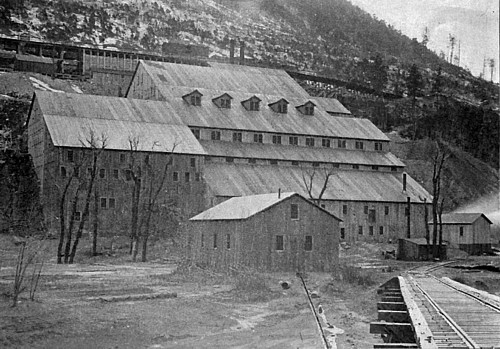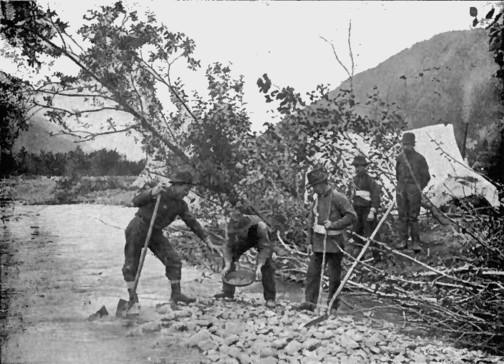The early records of the camp are full of similar episodes; that was before the railroad brought in civilization. The great strike of 1894, with its fortification on Bull Hill, its intrigues, and its threatened rebellion against the state troops, is an incident in national history. They show you now "where the battle was fought." They point to the place where the deputies marshalled their forces, where the Governor took his position, where the embattled miners stood and fired nearly precipitating a civil war in the Rockies. That was in the "old days."
FIRST HOTEL IN CRIPPLE
CREEK
It seems strange to hear people speak of the year 1894 as "an early
day," yet that is the way they talk in Cripple Creek. Where events move
rapidly history writes a book every day. The early history, the story of the
prehistoric period say, in the "eighties" is now almost forgotten. Greater
events are now upon the boards. The world has its eye upon Cripple Creek as
it is. The cry of "a million a month" is a slogan that will not permit
ancient history to do much business. That slogan is providing work for
thousands of miners. Three eight-hour shifts make midnight in the mine as
busy as noon. Electric lights in the depths make work as safe as it is above
ground. Wages for miners are three dollars for eight hours. The Union rules
everything. Business is too brisk to permit a quarrel. Mechanics earn four
dollars a day, and carpenters and masons find plenty to do at wages in
keeping with the times. The cost of living is reasonable. Flour sells at
$1.10 to $1.25, and meat at Missouri River prices. Vegetables are plenty.
Rent only is high. That may be avoided by owning a home, as taxes are
reasonably low, and outside the business part of town building lots may be
purchased on excellent terms.
It is proper
to state that a speculative boom is under way in Cripple Creek mining
stocks. No one pretends that this
gold rush boom will last forever, but the success of Cripple Creek
does not depend upon the market price of its stocks. The existence of a
phenomenal
gold deposit has been conclusively established.
The fact that there may be worthless Cripple Creek stocks in eastern markets has no bearing on the actual and permanent values of the numerous rich strikes. Hundreds of thousands of dollars of outside capital are being sent to Colorado to be used in almost indiscriminate mining-stock speculation, and the price of nearly every stock on the market has steadily and rapidly risen. Of course a day will come when the wheat will be sifted from the chaff, but at present every stock that represents an actual property in the district is regarded as possible wheat. At the present writing there are 980 mining companies incorporated in the Cripple Creek district. Less than fifty of these have been listed on the Colorado Stock Exchange. Some are regarded as so valuable by the original owners that none of the stock is offered, but the greater number represent properties either of unknown or undeveloped value. Only seventy of these stocks, out of nearly one thousand, are "on call" in the Exchange at Cripple Creek. The best equipped mine in the district is the "Independence." Over this mine is a large shaft house filled with machinery. A dynamo, provides illumination under ground. The system of signals is electrical. Steam pumps bring up water by the thousand gallons. Steel cables hoist the cages in the shaft, and the foreman, sitting by an electric keyboard, with a lever in his hand, directs the work that brings millions of dollars worth of ore to the world. It is a triumph of mechanics. Danger of loss of life is minimized, the moral is, not that the unlisted stocks are worthless, although some are undoubtedly "wildcat," but that the wise investor will personally visit the camp before investing his money. Of course the producing mines are known. Their stocks can generally be purchased, but the price is much higher and the speculative range naturally less than is possible with less developed mines. To the reader who is not familiar with modern mining methods, a glance at the amount of machinery used in lifting the gold-bearing rock to the labor is saved and the miracle of producing wealth goes on day and night.
Shaft houses similar to that of the "Independence" are dotted all over the group of hills that comprise the district. Every week a new shaft house goes up. There are now over two hundred mines that are lifting ore in paying quantities. Most of these are owned by private parties or by close corporations. There are a great many Cripple Creek mines that have shipped gold ore in paying quantities or have it in sight.
It has already been stated that most of the producing mines are in the hands of private owners. There is good reason for this. Good mining stock is valuable. It is taken up rapidly in Colorado. A mining company on an established paying basis soon becomes practically a close corporation. It is the best investment in the world. However there are also a number of gold mining stocks called on the Cripple Creek board. They are well capitalized and their price per share is publically noted. Every day the territory is enlarging. Hills that were considered worthless are found each month to be veritable quarries of gold. Prospect holes are transformed into ore-shipping mines. Is it a wonder that those who have seen this miracle are enthusiastic?
Here is the way the Rocky Mountain News one of Denver's conservative daily papers looks at the product of these 203 mines and the possibilities of the "camp" In the early days: "The Cripple Creek district is the richest and most promising gold field in the world. During the past year the district has attracted the attention of two continents. Gold has been unearthed in such quantities, and the veins have been of such surpassing richness, as to astonish prospector and investor. In the much vaunted gold fields of South Africa, ore is treated that yields not to exceed $12 a ton. In the Cripple Creek region, Colorado, the average value of ore per ton is from $75 to $100, and some of it runs as high as $20,000 per ton, reaching in isolated cases to $40,000. What is considered excellent product in the Kaffir mines is thrown upon the waste pile as not worthy of the expense of extraction in the fields that lie upon the slopes of Battle Mountain. Results speak for themselves. Thousands of people from all over the civilized world have, during the past few months, walked these hills, and what they have seen and heard will form the pages of history. Eighteen ninety-five, with its surprising finds, will, when the eventful history of Cripple Creek is closed, be conceded as the red-letter year, from which the renewed prosperity of Colorado received its greatest impetus.
It is probable, it is certainly possible, that this New Year, at its death, will show a record of over $15,000,000 in gold taken from the earth in Cripple Creek. But the old year that has passed from the stage will be reverenced as the period in which the greatness of the future was made known, which attracted to these mines the men of the civilized world, and which invited, by the worth of the product, capital from sister states and from abroad. In the day when the output of Colorado's yellow metal shall equal that of all the rest of the world, the past year will be remembered as the father of all the grand result."
Return
to The Colorado History Page:
Colorado Gold Rush History


